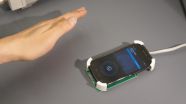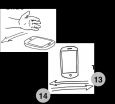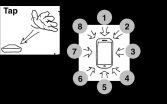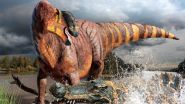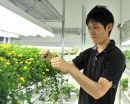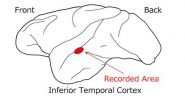(Press-News.org) With almost all of the U.S. population armed with cellphones – and close to 80 percent carrying a smartphone – mobile phones have become second-nature for most people.
What's coming next, say University of Washington researchers, is the ability to interact with our devices not just with touchscreens, but through gestures in the space around the phone. Some smartphones are starting to incorporate 3-D gesture sensing based on cameras, for example, but cameras consume significant battery power and require a clear view of the user's hands.
UW engineers have developed a new form of low-power wireless sensing technology that could soon contribute to this growing field by letting users "train" their smartphones to recognize and respond to specific hand gestures near the phone.
The technology – developed in the labs of Matt Reynolds and Shwetak Patel, UW associate professors of electrical engineering and of computer science and engineering – uses the phone's wireless transmissions to sense nearby gestures, so it works when a device is out of sight in a pocket or bag and could easily be built into future smartphones and tablets.
"Today's smartphones have many different sensors built in, ranging from cameras to accelerometers and gyroscopes that can track the motion of the phone itself," Reynolds said. "We have developed a new type of sensor that uses the reflection of the phone's own wireless transmissions to sense nearby gestures, enabling users to interact with their phones even when they are not holding the phone, looking at the display or touching the screen."
Team members will present their project, called SideSwipe, and a related paper Oct. 8 at the Association for Computing Machinery's Symposium on User Interface Software and Technology in Honolulu.
When a person makes a call or an app exchanges data with the Internet, a phone transmits radio signals on a 2G, 3G or 4G cellular network to communicate with a cellular base station. When a user's hand moves through space near the phone, the user's body reflects some of the transmitted signal back toward the phone.
The new system uses multiple small antennas to capture the changes in the reflected signal and classify the changes to detect the type of gesture performed. In this way, tapping, hovering and sliding gestures could correspond to various commands for the phone, such as silencing a ring, changing which song is playing or muting the speakerphone. Because the phone's wireless transmissions pass easily through the fabric of clothing or a handbag, the system works even when the phone is stowed away.
"This approach allows us to make the entire space around the phone an interaction space, going beyond a typical touchscreen interface," Patel said. "You can interact with the phone without even seeing the display by using gestures in the 3-D space around the phone."
A group of 10 study participants tested the technology by performing 14 different hand gestures – including hovering, sliding and tapping – in various positions around a smartphone. Each time, the phone was calibrated by learning a user's hand movements, then trained itself to respond. The team found the smartphone recognized gestures with about 87 percent accuracy.
There are other gesture-based technologies, such as "AllSee" and "WiSee" recently developed at the UW, but researchers say there are important advantages to the new approach.
"SideSwipe's directional antenna approach makes interaction with the phone completely self-contained, because you're not depending on anything in the environment other than the phone's own transmissions," Reynolds said. "Because the SideSwipe sensor is based only on low-power receivers and relatively simple signal processing compared with video from a camera, we expect SideSwipe would have a minimal impact on battery life."
The team has filed patents on the technology and will continue developing SideSwipe, integrating the hardware and making a "plug and play" device that could be built into smartphones, said Chen Zhao, project lead and a UW doctoral student in electrical engineering.
INFORMATION:
Other co-authors are Ke-Yu Chen, a UW doctoral student in electrical engineering, and Md Tanvir Islam Aumi, a doctoral student in computer science and engineering.
This research was funded by the UW.
For more information, contact Reynolds at matt.reynolds@ee.washington.edu or 206-616-5046.
Reflected smartphone transmissions enable gesture control
2014-09-19
ELSE PRESS RELEASES FROM THIS DATE:
Patients with advanced, incurable cancer denied palliative care
2014-09-19
Many patients with advanced, incurable cancer do not receive any palliative care, reveals new research to be presented later this month at the ESMO 2014 Congress in Madrid, Spain, 26-30 September. The findings are astonishing as they come at the same time as 15 new oncology centres in Europe, Canada, South America and Africa are being awarded the prestigious title of 'ESMO Designated Centre of Integrated Oncology and Palliative Care.'
SR I Dr Alexandru Grigorescu, medical oncology consultant at the Institute of Oncology Bucharest, Romania, member of the ESMO Palliative ...
Graphene sensor tracks down cancer biomarkers
2014-09-19
An ultrasensitive biosensor made from the wonder material graphene has been used to detect molecules that indicate an increased risk of developing cancer.
The biosensor has been shown to be more than five times more sensitive than bioassay tests currently in use, and was able to provide results in a matter of minutes, opening up the possibility of a rapid, point-of-care diagnostic tool for patients.
The biosensor has been presented today, 19 September, in IOP Publishing's journal 2D Materials.
To develop a viable bionsensor, the researchers, from the University of ...
Simple test can help detect Alzheimer's before dementia signs show: York U study
2014-09-19
TORONTO, Sept. 19, 2014 — York University researchers say a simple test that combines thinking and movement can help to detect heightened risk for developing Alzheimer's disease in a person, even before there are any telltale behavioural signs of dementia.
Faculty of Health Professor Lauren Sergio and PhD candidate Kara Hawkins who led the study asked the participants to complete four increasingly demanding visual-spatial and cognitive-motor tasks, on dual screen laptop computers. The test aimed at detecting the tendency for Alzheimer's in those who were having cognitive ...
Shrink-wrapping spacesuits
2014-09-19
For future astronauts, the process of suiting up may go something like this: Instead of climbing into a conventional, bulky, gas-pressurized suit, an astronaut may don a lightweight, stretchy garment, lined with tiny, musclelike coils. She would then plug in to a spacecraft's power supply, triggering the coils to contract and essentially shrink-wrap the garment around her body.
The skintight, pressurized suit would not only support the astronaut, but would give her much more freedom to move during planetary exploration. To take the suit off, she would only have to apply ...
New hadrosaur noses into spotlight
2014-09-19
Call it the Jimmy Durante of dinosaurs – a newly discovered hadrosaur with a truly distinctive nasal profile. The new dinosaur, named Rhinorex condrupus by paleontologists from North Carolina State University and Brigham Young University, lived in what is now Utah approximately 75 million years ago during the Late Cretaceous period.
Rhinorex, which translates roughly into "King Nose," was a plant-eater and a close relative of other Cretaceous hadrosaurs like Parasaurolophus and Edmontosaurus. Hadrosaurs are usually identified by bony crests that extended from the skull, ...
Researchers discover new gene responsible for traits involved in diabetes
2014-09-19
A collaborative research team led by Medical College of Wisconsin (MCW) scientists has identified a new gene associated with fasting glucose and insulin levels in rats, mice and in humans. The findings are published in the September issue of Genetics.
Leah Solberg Woods, Ph.D., associate professor of pediatrics at MCW and a researcher in the Children's Hospital of Wisconsin Research Institute, led the study and is the corresponding author of the paper.
The authors of the paper identified a gene called Tpcn2 in which a variant was associated with fasting glucose levels ...
Don't cry wolf: Drivers fed up with slowing down at inactive roadwork sites
2014-09-19
The results of the QUT Centre for Accident Research & Road Safety - Queensland (CARRS-Q) study have been presented at the Occupational Safety in Transport Conference (OSIT) which is being held on the Gold Coast and finishes today.
Dr Ross Blackman, a CARRS-Q road safety researcher, said speed limit credibility was being put at risk when reduced speed limits and related traffic controls remained in place at inactive roadwork sites.
"It's seen as crying wolf. If people are asked to slow down at roadwork sites but find there is no roadwork being undertaken they become ...
Long-distance communication from leaves to roots
2014-09-19
Leguminous plants are able to grow well in infertile land, and bear many beans that are important to humans. The reason for this is because most legumes have a symbiotic relationship with bacteria, called rhizobia, that can fix nitrogen in the air and then supply the host plant with ammonia as a nutrient.
The plants create symbiotic organs called nodules in their roots. However, if too many root nodules are made it will adversely affect the growth of the plants, because the energy cost of maintaining excessive nodules is too large. Therefore legumes must have a mechanism ...
Lymphatic fluid used for first time to detect bovine paratuberculosis
2014-09-19
Paratuberculosis, also known as Johne's disease, is caused by the bacterium Mycobacterium avium subspecies paratuberculosis (MAP). In Austria, there is a legal obligation to report the disease. Paratuberculosis mainly affects ruminants and causes treatment-resistant diarrhoea and wasting among affected animals. The disease can cause considerable economic losses for commercial farms. The animals produce less milk, exhibit fertility problems and are more susceptible to other conditions such as udder inflammation.
To date there has been no treatment for paratuberculosis. ...
Neurons express 'gloss' using three perceptual parameters
2014-09-19
Japanese researchers showed monkeys a number of images representing various glosses and then they measured the responses of 39 neurons by using microelectrodes. They found that a specific population of neurons changed the intensities of the responses linearly according to either the contrast-of-highlight, sharpness-of-highlight, or brightness of the object. This shows that these 3 perceptual parameters are used as parameters when the brain recognizes a variety of glosses. They also found that different parameters are represented by different populations of neurons. This ...
